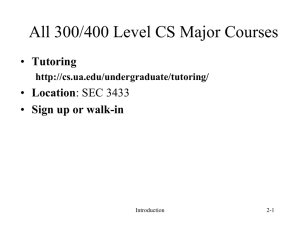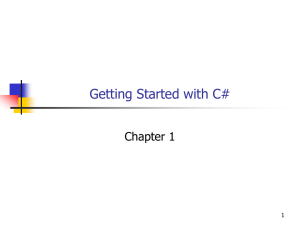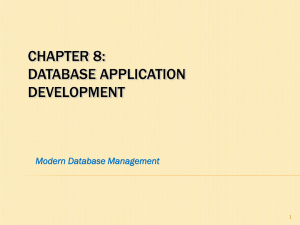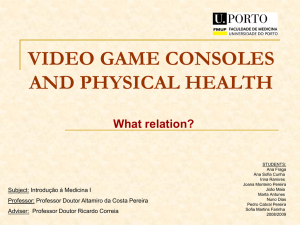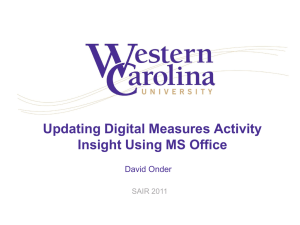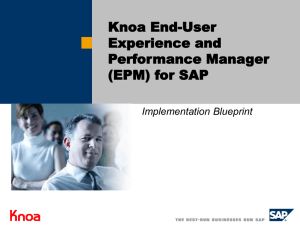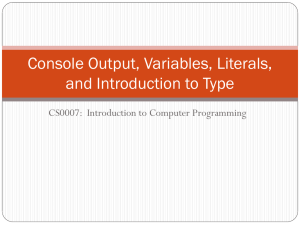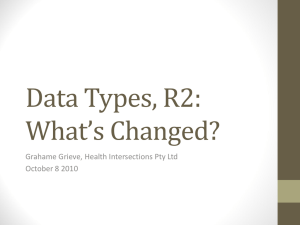Session1_Module1-2_Intro_Variables_Datatypes - fpt
advertisement
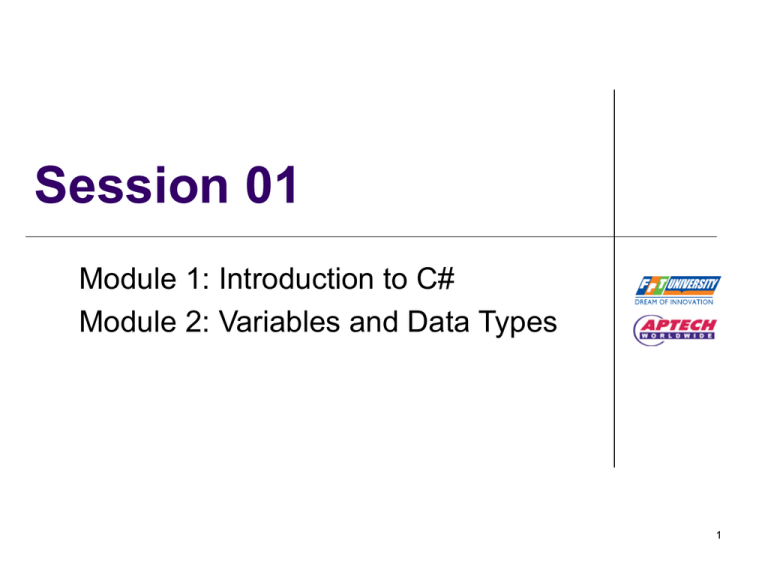
Session 01
Module 1: Introduction to C#
Module 2: Variables and Data Types
1
Module1 - Objectives
Describe the .NET Framework
List the other components of .NET Framework
Explain CLR and MSIL
Define Memory Management and Garbage
Collection
Describe the Microsoft Visual Studio 2005
product
Learn the key elements of Visual Studio 2005
IDE
List the basic features of C#
Introduction & Variables & Data types / Session 1 / 2 of 41
Architecture of .Net Framework(1)
The .Net Framework is a multi-lingual
environment to build, deploy and run
applications
It enables programmers to develop
applications for various platform such as
mobile
devices,
desktop
computer,
smartphones and so on.
Introduction & Variables & Data types / Session 1 / 3 of 41
Architecture of .Net Framework(2)
The .Net Framework architecture
comprises of following:
Languages included in the .Net Framework
.Net Framework class library (FCL)
The Common Language Runtime(CLR)
Introduction & Variables & Data types / Session 1 / 4 of 41
Architecture of .Net Framework(3)
Other importance components in .Net Framework
Web Forms
Web services
Windows Forms
ASP.NET
ADO.NET
XML Classes
Base Framework Classes
Common Language Specification
Common Type System
Introduction & Variables & Data types / Session 1 / 5 of 41
Microsoft Intermediate Language(MSIL)
When code written in .Net Framework
language such as C#,VB…is complied,
output code is in the form of Microsoft
Intermediate Language(MSIL)
Introduction & Variables & Data types / Session 1 / 6 of 41
Common Language Runtime(CLR)
When a code is executed for first time, the
MSIL code is converted to a code native to
operating system.
This is done ar runtime by the Just-inTime(JIT) compiler present in CLR.
Introduction & Variables & Data types / Session 1 / 7 of 41
Basic Features of C#
Object-oriented programming language
Type safety checking
Garbage collection
Standarbisation by ECMA(European
Computer Manufacturers Association)
Generic Types and Methods
Introduction & Variables & Data types / Session 1 / 8 of 41
Visual Studio 2005(1)
Visual studio 2005 is complete set of
development tools to build desktop
applications, web application, XML web
service and mobile applications.
Primary advantages are:
Development of applications for .Net Framework
2.0
Development of applications for handheld devices
using .Net Compact Framework 2.0
Introduction & Variables & Data types / Session 1 / 9 of 41
Visual Studio 2005(2)
Introduction & Variables & Data types / Session 1 / 10 of 41
Key elements of VS 2005
Solution Explorer
Code Editor
Properties Window
Dynamic help
Introduction & Variables & Data types / Session 1 / 11 of 41
Write and run first console application
Step 1: Create new project
Introduction & Variables & Data types / Session 1 / 12 of 41
Write and run first console application
Step 2:Compile program
You can compile console application from
command line or use IDE
If compile program from command line:
Edit PATH variable, add following line in PATH
C:\WINDOWS\Microsoft.NET\Framework\v2.0.50727;
in command line window, change to directory of
program and type: csc <fileName.cs>
If use IDE, press F6 to compile program
Introduction & Variables & Data types / Session 1 / 13 of 41
Write and run first console application
Step 3: Run program
If use command line window, type .exe file name
If use IDE, press Ctrl + F5
Introduction & Variables & Data types / Session 1 / 14 of 41
Module 1 – Summary (1)
.Net Framework is multi-language platform to build,
deploy and run various types of applications
Two major components of .Net Framework is CLR
and FCL
When code is written in .Net language such as
C#,VB…compiled, output code is converted to code
native to operating system by Just-In-Time language
Introduction & Variables & Data types / Session 1 / 15 of 41
Module 1 – Summary (2)
C# is an object-oriented programming language
derived from c and C++.
C# support features like type-safety checking,
garbage collection, ECMA standardization, generics
Visual studio 2005 is complete set of tool to build
high performance applications
Introduction & Variables & Data types / Session 1 / 16 of 41
Module 2 - Objectives
Identify basic data types in C#
Explain XML source code documentation
List the keywords in C#
Describe reference data types
Constants and Literals
Describe console output methods in C#
Explain number and datetime format
specifiers
Introduction & Variables & Data types / Session 1 / 17 of 41
Variables
A variable is an entity whose value can keep
changing
Declaration syntax:
<datatype> <variableName>
[,variableName=<value>];
Assignment syntax:
<variable> = <value>;
Introduction & Variables & Data types / Session 1 / 18 of 41
Data Types (1)
In C#, data types are also divided into two
categories:
Value types:
Can be either the built-in data type or a user-defined
data type.
Stack storage results in faster memory allocation to
variables of value types
Reference types:
Variables of reference type store the memory address
of other variables in a heap.
Most of user-defined data types such as class are
reference types.
Introduction & Variables & Data types / Session 1 / 19 of 41
Data Types (2)
Introduction & Variables & Data types / Session 1 / 20 of 41
Predefined Data Types (1)
The predefined data types are referred to as
basic data types in C#.
These data types have a predefined range
and size.
The size of the data type helps the compiler
to allocate memory space and ensure the
value assigned is within the range of the data
type.
Introduction & Variables & Data types / Session 1 / 21 of 41
Predefined Data Types (2)
Introduction & Variables & Data types / Session 1 / 22 of 41
Reference Data Type Classification
Reference types can be classified as
Introduction & Variables & Data types / Session 1 / 23 of 41
Some Reference Data Types
Introduction & Variables & Data types / Session 1 / 24 of 41
Variable Naming Rules
Introduction & Variables & Data types / Session 1 / 25 of 41
Comments
Comments are given by programmer to provide
information about a piece of code.
Comments make the program more readable.
Comments help the programmer to explain the purpose
of using a particular variable, method, class, or code
snippet.
Comments are ignored by the compiler during the
execution of the program.
C# supports three types of comments:
Single-line comments
Multiple-line comments
XML comments
Introduction & Variables & Data types / Session 1 / 26 of 41
XML Documentation
In C#, we can create an XML document that will contain all the XML
comments.
This document is useful when multiple programmers want to view
information of the program.
To create an XML document, we must use the VS 2005 command
prompt window.
csc /doc:<XMLfilename.xml> <CSharpfilename.cs>
Introduction & Variables & Data types / Session 1 / 27 of 41
Predefined XML Tags
XML comments are inserted in XML tags. These tags
can either be predefined or user-defined.
XML comments begin with three forward slashes (///)
Introduction & Variables & Data types / Session 1 / 28 of 41
Constants
Constants are fixed values assigned to
identifiers that are not modified throughout
the execution of the code.
We have to initialize a constant at the time of
its declaration.
The compiler can identify constants at the
time of compilation because of the const
keyword.
Introduction & Variables & Data types / Session 1 / 29 of 41
Literals
A literal is a static value assigned to variables
and constants
In C#, there are six types of literals
Introduction & Variables & Data types / Session 1 / 30 of 41
Keywords
Keywords are reserved words and are separately compiled by
the compiler.
They convey a predefined meaning to the compiler and hence
cannot be created or modified.
Introduction & Variables & Data types / Session 1 / 31 of 41
Escape sequence characters in
C#
Introduction & Variables & Data types / Session 1 / 32 of 41
Console Input/Output Operations
Two output methods: Console.Write() and
Console.WriteLine()
These two methods accept parameters for
formatting the text before the output is
displayed
Console.Write(“Customer name: {0}”, custName);
Console.WriteLine(“Total amount: ${0:#,###.#0}”, totalAmount);
Two input methods: Console.Read() and
Console.ReadLine()
custName = Console.ReadLine();
Introduction & Variables & Data types / Session 1 / 33 of 41
Convert Methods
The ReadLine() method can also be used
to accept integer values.
The data is accepted as string and then
converted into other data type by a
Convert class
age = Convert.ToInt32(Console.ReadLine());
Introduction & Variables & Data types / Session 1 / 34 of 41
Format Specifiers
Format specifiers are special characters
that are used to display values of variables
in a formatted manner.
Some type of format specifiers
Number Format Specifiers
Datetime Format Specifiers
Introduction & Variables & Data types / Session 1 / 35 of 41
Number Format Specifiers
We can convert numeric values in different
formats.
Introduction & Variables & Data types / Session 1 / 36 of 41
More Number Format Specifiers
Introduction & Variables & Data types / Session 1 / 37 of 41
Datetime Format Specifiers
Introduction & Variables & Data types / Session 1 / 38 of 41
More Datetime Format Specifiers
Introduction & Variables & Data types / Session 1 / 39 of 41
Module 2 – Summary (1)
In C#, data types are also divided into two
categories: value types and reference types
The predefined data types are referred to as
basic data types in C#.
C# supports three types of comments
XML comments are inserted in XML tags.
These tags can either be predefined or userdefined.
Introduction & Variables & Data types / Session 1 / 40 of 41
Module 2 – Summary (2)
Two output methods: Console.Write() and
Console.WriteLine()
Two input methods: Console.Read() and
Console.ReadLine()
Convert class is used to convert a variable
into another data type.
Some type of format specifiers: number and
datatime
Introduction & Variables & Data types / Session 1 / 41 of 41

